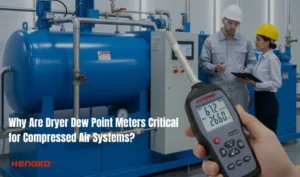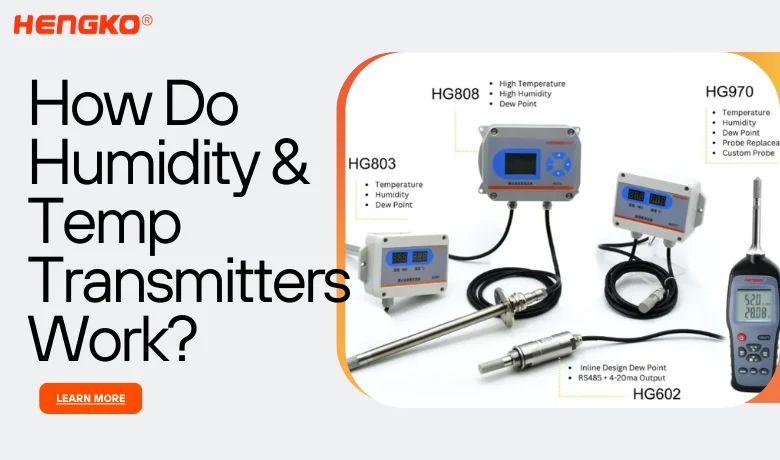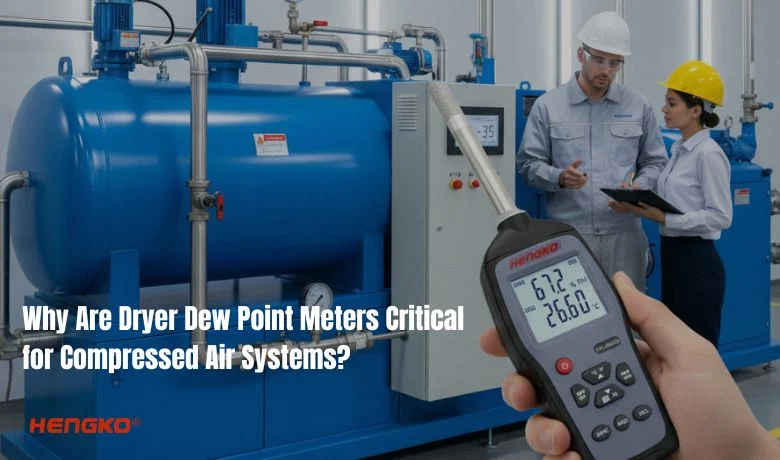
Kaip veikia drėgmės ir temperatūros siųstuvai?
In short, Humidity and temperature transmitters measure and send environmental data to control systems. They
Reliable OEM Partner for Dew Point Monitoring in Compressed Air, Gas, and Drying Systems
Pagrindinis " Rasos taško matuoklis
Designed for precision and durability, the HENGKO HG970 series offers a reliable dew point monitoring solution for demanding industrial environments. With high accuracy, fast response time, and robust stainless steel construction, the HG970 is ideal for continuous online measurement in compressed air systems, gas drying lines, and moisture-sensitive production processes. Whether you need analog or digital output, the HG970 series ensures stable performance and seamless integration into your control systems.
HG970 Series Dew Point Meter/ Temperature Humidity Selection Guide
| Modelis | Temperatūros diapazonas | Measurement Ranges (Humidity / Dew Point / Wet Bulb) | Accuracy (Temp / RH / Dew Point) | Zondo tipas | Paraiška | Features / Notes |
| HG970 | -30 ~ 80℃ | Humidity Range: 0 ~ 100%RH / Dew Point Range: -30 ~ 80°C Td / Wet Bulb Range: 0 ~ 60°C WB | ±0.1℃ / ±1.5%RH / ±3°C Td | Replaceable Probe | General-purpose monitoring in HVAC systems, laboratories, and industrial rooms | Standard model with easy-to-replace probe for regular maintenance |
| HG972 | -30 ~ 80℃ | Humidity Range: 0 ~ 100%RH / Dew Point Range: -30 ~ 80°C Td / Wet Bulb Range: 0 ~ 60°C WB | ±0.1℃ / ±1.5%RH / ±3°C Td | Round Probe | Compact systems like environmental test chambers, storage cabinets, or small control boxes | Space-saving round probe for tight installations |
| HG984 | -30 ~ 80℃ | Humidity Range: 0 ~ 100%RH / Dew Point Range: -30 ~ 80°C Td / Wet Bulb Range: 0 ~ 60°C WB | ±0.1℃ / ±1.5%RH / ±3°C Td | OEM Sharp Probe | OEM integration in compact equipment, sensor assemblies, or instrument panels | Custom sharp probe for embedded and OEM applications |
| HG983 | -30 ~ 100℃ | Humidity Range: 0 ~ 100%RH / Dew Point Range: -30 ~ 80°C Td / Wet Bulb Range: 0 ~ 60°C WB | ±0.1℃ / ±1.5%RH / ±3°C Td | Long Sharp Probe | Compressed air pipelines, drying ovens, and tank inlets | Extended reach probe ideal for insertion into ducts or deep ports |
| HG981 | -30 ~ 120℃ | Humidity Range: 0 ~ 100%RH / Dew Point Range: -30 ~ 80°C Td / Wet Bulb Range: 0 ~ 60°C WB | ±0.1℃ / ±1.5%RH / ±3°C Td | OEM Long Probe | Lithium battery drying rooms, petrochemical high-temp gas lines | Long and durable probe for harsh, high-temperature applications |
| HG982 | -30 ~ 120℃ | Humidity Range: 0 ~ 100%RH / Dew Point Range: -30 ~ 80°C Td / Wet Bulb Range: 0 ~ 60°C WB | ±0.1℃ / ±1.5%RH / ±3°C Td | Split Sharp Probe | Industrial dryers, heated air chambers, or environments with difficult access | Split design for easier installation and probe positioning |
HG970 Series
Portable Dew Point Meter HG970 – Precision in Your Pocket
The Portable Dew Point Meter is a lightweight, field-ready device designed for fast,
accurate humidity and dew point measurements in a wide range of environments.
*Compact & Portable – Ideal for mobile use in field inspections and remote sites
*High Accuracy – Advanced sensors ensure precise dew point readings
*Versatile Applications – Suitable for HVAC checks, industrial spot measurements, and environmental monitoring
*Rapid Response – Quickly adapts to changing conditions for real-time results
*User-Friendly Interface – Simple controls and clear display for effortless operation
*Durable & Lightweight – Built to withstand demanding field conditions without added bulk
*Essential Tool – A must-have for professionals requiring reliable moisture data on the go
"HENGKO" yra pasaulinė pramoninių jutiklių sprendimų lyderė, garsėjanti unikaliu dizainu ir puikiomis eksploatacinėmis savybėmis. Mūsų temperatūros ir drėgmės siųstuvai ir jutikliai naudojami įvairiose pramonės šakose, įskaitant maisto ir gėrimų, farmacijos, gamybos ir aplinkos stebėjimo pramonę.
Galite visiškai pritaikyti unikalų rasos taško jutiklio gaminį pagal mūsų patentuotą ir pačių sukurtą rasos taško siųstuvų seriją.
Dėl mūsų itin ekonomiškos kontrolės gausite daug mažesnę ir konkurencingą kainą.
Su mūsų nuolat atnaujinamais produktais visada patenkinsite nuolat kintančius rinkos poreikius.
Gausite stiprią rinkodaros paramą, kuri padės jums sėkmingai parduoti produktus, medžiaginė parama apima: didelės raiškos produktų vaizdus, kietus 3d efekto vaizdo įrašus ir daug daugiau.










Suspausto oro sistemos monitoriaus rasos taško jutiklis: optimalios drėgmės kontrolės ir oro kokybės užtikrinimas jūsų oro suspaudimo mašinai
HENGKO is a trusted manufacturer of high-performance dew point transmitters, temperature and humidity transmitters, and portable dew point meters.
We specialize in delivering a comprehensive range of monitoring solutions tailored to meet the precise needs of industrial and environmental applications.
Engineered for accuracy, durability, and long-term stability, our products ensure reliable performance across demanding conditions. Whether you’re looking for a precise dew point sensor or a rugged humidity transmitter, HENGKO offers both the technology and expertise to support your project.
👉 Contact us today to explore customized solutions that fit your monitoring challenges.






A Rasos taško matuoklis is a precision instrument used to measure the dew point temperature—the temperature at which moisture in the air or gas begins to condense into liquid water. It is a key parameter for understanding humidity levels ir moisture content in various industrial and environmental applications.
Priemonės dew point temperature in °C or °F
Indicates humidity saturation in air or gases
Helps detect moisture contamination in compressed air, gases, or controlled environments
Compressed air systems (prevent water accumulation)
Gas drying processes (e.g. nitrogen, argon, hydrogen)
ŠVOK sistemos (ensure indoor climate control)
Lithium battery dry rooms (moisture-sensitive environments)
Pharmaceutical & food production (humidity-sensitive storage)
| Tipas | Aprašymas |
|---|---|
| Portable Dew Point Meter | Handheld, used for spot-checks and field diagnostics |
| Online Dew Point Transmitter | Fixed installation, sends real-time data to control systems (e.g. 4–20 mA, RS485) |
| Mirror-type Hygrometer | Laboratory-grade, ultra-accurate but costly |
Prevents corrosion, condensation, and product defects
Ensures compliance with industry standards (ISO, GMP, etc.)
Enhances energy efficiency and equipment lifespan
Checking the dew point with the HG970 series portable dew point meter from HENGKO is a precise, efficient, and reliable process designed for both industrial field inspections and laboratory-quality measurements. The HG970 series offers various probe configurations to suit a wide range of applications, from general HVAC systems to high-temperature drying environments. Below is a step-by-step guide and technical overview of how the dew point measurement is conducted using this instrument.
The HG970 series includes multiple probe types (e.g., replaceable, sharp, long, split) and temperature ranges (-30°C to 120°C), allowing users to choose the most suitable model based on their measurement environment. For example:
HG970 / HG972: Ideal for general industrial and HVAC applications.
HG981 / HG982: Recommended for high-temperature environments (80–120°C), such as lithium battery drying rooms and gas pipelines.
Ensure the device is powered (via external power supply or field setup).
Connect the probe securely to the test point, pipe port, or environmental chamber.
For accurate results, avoid exposing the sensor to sudden humidity shocks or contaminants like oil or dust before the reading stabilizes.
Once connected, the HG970’s built-in sensing module continuously samples the air or gas, measuring parameters such as:
Dew Point Temperature (°C or °F)
Relative Humidity (%RH)
Ambient Temperature (°C/°F)
These values are calculated using HENGKO’s advanced polymer capacitive or ceramic sensor technology, offering fast response time ir high accuracy even in dynamic or high-moisture environments.
If the model includes an LCD or digital interface (optional), the readings are displayed in real-time. For models without a display, the output is transmitted via:
Analog Signal (4–20 mA / 0–10 V)
Digital Communication (RS485 / Modbus-RTU)
These outputs can be logged via a data logger, PLC, or remote monitoring software.

The dew point temperature tells you the exact point at which condensation would occur under current pressure and humidity conditions. Lower dew points indicate drier air, which is critical for:
Preventing corrosion or moisture damage in pneumatic tools or compressed air systems
Maintaining strict humidity control in cleanrooms, dry rooms, or gas drying processes
For example:
Dew point < -40°C: Suitable for high-purity gas systems and lithium battery environments.
Dew point 0 ~ 10°C: Typical in HVAC, food storage, and general industrial applications.
To maintain reliable performance:
Calibrate the device periodically (typically once every 6–12 months) against a traceable standard.
Clean or replace the sensor probe as needed, especially if used in harsh or dusty environments.
Store the unit in a dry and clean place when not in use.
✅ Wide temperature and humidity range
✅ Interchangeable probe options for different environments
✅ Compact and robust construction for field use
✅ High accuracy and fast response time
✅ Optional OEM customization for unique industrial requirements
Contact HENGKO’s technical team at ka@hengko.com or visit www.hengkometer.com to get personalized advice based on your industry, installation method, and measurement conditions.
Svetainė HG970 series dew point transmitters from HENGKO are designed for industrial-grade dew point monitoring with high precision and stability. The normal dew point measurement range of the HG970 series is typically:
-60°C to +60°C Td (typical)
(Custom ranges available upon request)
| Parameter | Details |
|---|---|
| Typical Range | -60°C ~ +60°C dew point (Td) |
| Drėgmės diapazonas | 0%RH to 100%RH |
| Temperatūros diapazonas | -30°C to +120°C (varies by model, e.g., HG970 to HG982) |
| Sensor Type | Polymer capacitive or ceramic sensor (high accuracy, fast response) |
| Išėjimo signalas | 4–20mA, 0–5V, 0–10V, RS485 / Modbus-RTU |
| Tikslumas | ±2°C Td typical (customizable based on sensor class) |
-60°C to -20°C Td: Ideal for compressed air drying systems, lithium battery dry rooms, arba gas drying
-20°C to +20°C Td: Common in ŠVOK sistemos, pharmaceutical environments, ir storage facilities
+20°C to +60°C Td: Suitable for high-moisture process areas, arba climate chambers
If you need a customized dew point range, HENGKO can tailor the sensor configuration based on:
Target environment (dry gas, ambient air, high temp zone)
Accuracy requirement
Signal output preferences
📩 Contact: ka@hengko.com to request a custom specification or get technical support.
This is Great question!
Understanding the difference between rasos taškas ir drėgmė is key to accurately evaluating air moisture content
—especially in industrial, HVAC, and environmental monitoring applications.
| Aspect | Rasos taškas | Humidity (Relative Humidity, %RH) |
|---|---|---|
| Apibrėžimas | Svetainė temperatūra at which air becomes fully saturated and water vapor condenses into liquid | Svetainė percentage of water vapor in the air compared to the maximum it can hold at a given temperature |
| Unit | °C or °F (Temperature) | %RH (Percentage) |
| Absolute/Relative? | Absolute measure of moisture content | Relative measure (depends on air temperature) |
| Temperature Dependent? | No – dew point is not affected by ambient temperature | Yes – higher temperatures can hold more moisture, affecting %RH |
| What it tells you | How dry or moist the air actually is | How close the air is to saturation at a given temperature |
| Used for | Precise control in drying, gas purity, industrial process monitoring | General comfort, climate control, environmental monitoring |
| Example | Dew point of -40°C = extremely dry air (used in lithium battery rooms) | 60%RH at 25°C = moderately humid air |
Rasos taškas = “How much water is really in the air?”
Relative Humidity = “How full is the air’s moisture tank at this temperature?”
| Ambient Temp | Rasos taškas | Relative Humidity |
|---|---|---|
| 25°C | 10°C | ~45%RH |
| 25°C | 20°C | ~75%RH |
| 25°C | 24°C | ~95%RH |
Naudokite Rasos taškas for:
Compressed air drying systems
Inert gas monitoring (N₂, Ar, H₂)
Lithium battery dry rooms
Naudokite %RH for:
Indoor air quality
HVAC system control
Agricultural storage
Even though the temperature is the same, the dew point increases with more water vapor in the air, which raises the relative humidity.
Both devices are used to measure the dew point temperature, a critical parameter in determining moisture levels in air or gas. However, they differ significantly in design, application, ir integration method.
| Aspect | Aprašymas |
|---|---|
| Measurement Function | Both measure dew point temperature accurately to detect moisture levels |
| Sensor Technology | Typically use similar capacitive or ceramic humidity sensors |
| Target Media | Both used with air, compressed gases, dry gases, etc. |
| Paraiškos | Found in industrial, HVAC, environmental monitoring, ir gas drying |
| Feature / Aspect | Rasos taško matuoklis | Rasos taško siųstuvas |
|---|---|---|
| Form Factor | Portable or handheld | Fixed-installation / inline sensor |
| Display | Built-in LCD or digital display | Usually no display (or optional), outputs data to external systems |
| Power Source | Battery-powered or rechargeable | Externally powered (e.g., 24V DC) |
| Išėjimo signalas | Internal data logging, USB export (optional) | Analog (4-20 mA, 0-10V) or Digital (RS485/Modbus-RTU) |
| Use Case | On-site spot checks, mobile inspections | Continuous online monitoring & automation systems |
| User Type | Technicians, maintenance staff | Engineers, system integrators, automation specialists |
| Įrengimas | Handheld use or temporary probe connection | Installed permanently in pipelines, dryers, tanks, etc. |
| Kainų diapazonas | Generally higher due to display and portability features | More cost-effective for long-term embedded use |
| Typical Examples | Vaisala DM70, Michell MDM300, HG970 series | HENGKO HG970, Vaisala DMT143, E+E EE371 |
| Scenario | Recommended Device |
|---|---|
| Field diagnostics and mobile inspections | Rasos taško matuoklis |
| Continuous monitoring in a compressed air line | Rasos taško siųstuvas |
| Temporary measurements in different locations | Rasos taško matuoklis |
| Integration into control/SCADA systems | Rasos taško siųstuvas |
Dew Point Meters are portable tools designed for manual measurements, great for spot-checking and troubleshooting.
Dew Point Transmitters are installed devices built for long-term, real-time monitoring ir system automation.
4-20 mA išvestis yra populiarus rasos taško jutiklių pasirinkimas, nes tai standartinė pramoninė išvestis, suderinama su įvairiomis valdymo sistemomis. Be to, ši išvestis yra labai patikima ir atspari triukšmui, todėl puikiai tinka naudoti atšiaurioje pramoninėje aplinkoje.
Štai keletas 4-20 mA išvesties naudojimo rasos taško jutikliuose privalumų:
Suderinamumas: 4-20 mA išvestis suderinama su įvairiomis valdymo sistemomis, įskaitant PLC, DCS ir SCADA sistemas. Todėl rasos taško jutiklius lengva integruoti į esamas valdymo sistemas.
Patikimumas: 4-20 mA išvestis yra labai patikima išvestis, kuri nėra jautri triukšmo trikdžiams. Tai svarbu rasos taško jutikliams, kurie dažnai naudojami atšiaurioje pramoninėje aplinkoje.
Tikslumas: 4-20 mA išvestis gali užtikrinti tikslius rasos taško matavimus. Tai svarbu tais atvejais, kai reikia tiksliai kontroliuoti rasos tašką.
Diapazonas: 4-20 mA išvestis gali apimti platų rasos taško verčių diapazoną. Dėl to jis tinka įvairioms programoms.
Išlaidos: 4-20 mA išvestis yra palyginti nebrangi išvestis. Dėl to ji yra ekonomiškas rasos taško jutiklių variantas.
Be pirmiau išvardytų privalumų, 4-20 mA išvestis taip pat yra labai universali išvestis. Ją galima naudoti įvairiems kitiems parametrams, pavyzdžiui, temperatūrai, slėgiui ir srautui, perduoti. Dėl to ši išvestis yra vertinga įvairioms pramoninėms reikmėms.
Toliau pateikiami keli pavyzdžiai, kur dažniausiai naudojami rasos taško jutikliai su 4-20 mA išėjimais:
Suspausto oro sistemos: Rasos taško jutikliai naudojami suslėgto oro sistemose oro drėgmei stebėti ir kontroliuoti. Tai svarbu siekiant išvengti korozijos ir kitų įrangos pažeidimų.
ŠVOK sistemos: Rasos taško jutikliai naudojami ŠVOK sistemose drėgmės lygiui pastatuose kontroliuoti. Tai svarbu žmonių komfortui ir sveikatai.
Pramoniniai džiovinimo procesai: Rasos taško jutikliai naudojami pramoniniuose džiovinimo procesuose, siekiant stebėti ir kontroliuoti džiovinamo produkto drėgmės kiekį. Tai svarbu siekiant užtikrinti produkto kokybę.
Maisto ir gėrimų perdirbimas: Rasos taško jutikliai naudojami maisto produktų ir gėrimų gamyboje drėgmės kiekiui apdorojamame produkte kontroliuoti. Tai svarbu siekiant užtikrinti produkto saugą ir kokybę.
Aplinkos stebėsena: Rasos taško jutikliai naudojami aplinkos stebėjimo stotyse, kad būtų galima stebėti drėgmės kiekio pokyčius atmosferoje. Ši informacija gali būti naudojama oro sąlygoms prognozuoti ir galimoms aplinkos problemoms nustatyti.
Kaip matote, rasos taško jutikliai su 4-20 mA išėjimais yra vertingas įrankis įvairiose pramonės srityse. Jie yra patikimi, tikslūs ir universalūs, be to, juos galima lengvai integruoti į esamas valdymo sistemas.
Rasos taško siųstuvų kaina gali skirtis priklausomai nuo gamintojo, funkcijų ir siųstuvo tikslumo. Apskritai rasos taško siųstuvai, pasižymintys didesniu tikslumu ir turinčios daugiau funkcijų, kainuoja brangiau nei rasos taško siųstuvai, pasižymintys mažesniu tikslumu ir turinčios mažiau funkcijų.
Remdamasis savo tyrimais, sakyčiau, kad rasos taško siųstuvų kaina paprastai yra teisinga. Rasos taško siųstuvų gamybai reikalingų komponentų ir darbo sąnaudos yra didelės, o rasos taško siųstuvus gaminančios įmonės, norėdamos išlikti versle, turi susigrąžinti šias sąnaudas. Be to, rasos taško siųstuvai naudojami įvairiose svarbiausiose srityse, todėl svarbu, kad jie būtų patikimi ir tikslūs. Aukšta rasos taško siųstuvų kaina atspindi tai, kad jie yra aukštos kokybės prietaisai, kuriais galima pasitikėti ir kurie užtikrina tikslius matavimus.
Štai keletas veiksnių, galinčių turėti įtakos rasos taško siųstuvo kainai:
Pateikiame rinkoje esančių rasos taško siųstuvų kainų intervalų lentelę:
| Tipas | Kainų diapazonas |
|---|---|
| Atšaldytas veidrodis | $2,000 – $10,000 |
| Polimeras | $500 – $2,000 |
| Metalo oksidas | $500 – $1,500 |
Kaip matote, rasos taško siųstuvų kainos gali skirtis priklausomai nuo siųstuvo tipo. Atšaldyto veidrodžio rasos taško siųstuvai yra brangiausias siųstuvų tipas, tačiau jie taip pat yra tiksliausi. Polimeriniai ir metalo oksido rasos taško siųstuvai yra pigesni, tačiau jie taip pat yra ne tokie tikslūs.
Rasos taško siųstuvų kaina taip pat gali skirtis priklausomai nuo siųstuvo funkcijų. Pavyzdžiui, rasos taško siųstuvai su duomenų registravimo, signalizacijos reikšmių nustatymo ir nuotolinės prieigos galimybėmis paprastai kainuoja brangiau nei mažiau funkcijų turintys rasos taško siųstuvai.
Jei ieškote aukštos kokybės rasos taško siųstuvo, rekomenduočiau įsigyti gerai žinomo prekės ženklo siųstuvą, kuris turi gerą reputaciją dėl kokybės ir patikimumo. Taip pat turėtumėte atsižvelgti į jums svarbias funkcijas ir reikiamą tikslumą. Jei nesate tikri, koks rasos taško siųstuvas jums tinka, rekomenduočiau pasikonsultuoti su specialistu, kuris padėtų priimti pagrįstą sprendimą.
some questions about Dew Point Meter you like to know
A Rasos taško matuoklis is a precision instrument used to measure the dew point temperature — the temperature at which air or gas becomes saturated with moisture and water vapor begins to condense into liquid.
It works by sensing the relative humidity and temperature of the environment or gas stream, then calculating the dew point based on the current saturation level. Most modern dew point meters use capacitive or ceramic sensors for real-time measurements, offering high accuracy and stability across a wide range of industrial applications.
Dew point measurement is critical for moisture control, especially in applications where excess humidity can lead to equipment failure, corrosion, product spoilage, or safety risks.
Industries such as suspausto oro sistemos, pharmaceuticals, lithium battery manufacturing, semiconductors, ir food packaging depend on dew point monitoring to ensure dry environments and gas purity. In compressed air lines, for example, a low dew point prevents water buildup, which could otherwise damage tools and contaminate end products.
Rasos taškas is the absolute temperature at which air becomes saturated and water vapor condenses, while humidity (usually relative humidity) is a percentage expressing how much moisture the air currently holds compared to its maximum capacity at a given temperature.
In simple terms:
Rasos taškas tells you how much moisture is actually in the air (in °C or °F).
Relative humidity tells you how close the air is to saturation (in %RH).
Dew point is more accurate for industrial applications, especially when monitoring drying processes or compressed air systems.
In industrial compressed air systems, the target dew point depends on the drying method ir application sensitivity:
| Paraiška | Recommended Dew Point |
|---|---|
| General industrial use | -20°C to -40°C |
| Instrumentation or electronics | -40°C to -70°C |
| Medical/Pharma cleanrooms | ≤ -40°C |
| Standard shop air (non-critical) | 0°C to -10°C |
A lower dew point means drier air, which is essential for high-performance or sensitive operations. The dew point meter helps monitor this and ensure system compliance.
Yes. Most dew point meters — including advanced portable models — can be used to measure dew point in a variety of non-corrosive gases, such as nitrogen (N₂), argon (Ar), carbon dioxide (CO₂), ir compressed natural gas (CNG).
However, it is important to verify:
Sensor compatibility with the target gas
Pressure rating of the probe or housing
Flow regulation to avoid sensor contamination
Some models, like the HENGKO HG970 series, offer custom probe materials and protective filters for specialized gas monitoring applications.
For most industrial and professional uses, dew point meters should be calibrated every 6 to 12 months, depending on usage frequency, environmental conditions, and accuracy requirements.
Regular calibration:
Ensures data reliability
Maintains regulatory compliance (e.g., ISO, GMP)
Extends the lifespan of the sensor
HENGKO and other manufacturers often offer traceable calibration services and replacement sensors for field units.
Typical high-quality portable dew point meters can measure within a range of:
-80°C to +60°C (or -112°F to +140°F)
For example, the HG970 series by HENGKO is commonly used to monitor dew point ranges from -60°C to +60°C, making it suitable for most industrial air and gas drying applications. Some lab-grade mirror hygrometers may extend lower, but portable models balance range with portability and cost-effectiveness.
Using a portable dew point meter is straightforward:
Power on the device (battery or external power).
Connect the probe to the sample point or open environment.
Allow stabilization time (usually 30 seconds to a few minutes).
Observe the real-time dew point reading on the display or via signal output.
Log or export data if required (some models offer USB or Bluetooth).
Always make sure the sensor is clean, calibrated, and not exposed to oil, dust, or corrosive chemicals.
A Rasos taško matuoklis is portable and often used for spot-checking or mobile diagnostics.
A Rasos taško siųstuvas is a fixed, inline sensor installed for continuous monitoring in automated systems.
Dew point meters typically include a display and internal battery, while transmitters are integrated with PLCs or data loggers via analog (4-20mA) or digital (RS485/Modbus) output.
Yes — if it’s rated for industrial or field use. Look for:
IP-rated housing for dust and moisture protection
Stainless steel probe construction
Temperature range compatibility (e.g., -30°C to +120°C)
Shock-resistant casing
Models like the HENGKO HG970 series are designed for demanding conditions, including outdoor gas lines, drying towers, arba factory production lines.
Susisiekite su "HENGKO" šiandien, jei turite klausimų dėl temperatūros ir drėgmės jutiklių, siųstuvų ir sprendimų

In short, Humidity and temperature transmitters measure and send environmental data to control systems. They

Why Are Dryer Dew Point Meters Critical for Compressed Air Systems? Maybe You always battle

Why One Office Zone is Too Humid & How a Humidity Transmitter Fixes It Persistent

Introduction Compressed air is often referred to as the “fourth utility” in modern industry, alongside

1. Introduction The semiconductor industry operates under some of the most stringent environmental conditions of
Kreipkitės į mūsų specialistų komandą, kad gautumėte asmeninę pagalbą, ir mes nedelsdami pasiūlysime geriausius temperatūros ir drėgmės siųstuvų bei jutiklių sprendimus, pritaikytus jūsų konkretiems poreikiams.

Trumpai tariant, drėgmės ir temperatūros siųstuvai matuoja ir siunčia aplinkos duomenis į valdymo sistemas. Jie plačiai naudojami ŠVOK, farmacijos, maisto perdirbimo ir švarių patalpų srityse.

In short, Humidity and temperature transmitters measure and send environmental

Why Are Dryer Dew Point Meters Critical for Compressed Air

Why One Office Zone is Too Humid & How a
"WhatsApp" mums